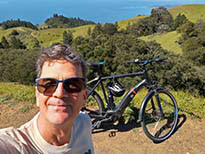* * *
It was still pouring rain when I arrived at the trailhead at the end of Lagunitas Road. I normally don't like to do photography in the rain, but in a year in which there's been so little rain it doesn't seem so bad. There are limits to the kinds of things you can reasonably photograph while fumbling with an umbrella, a tripod, and a backpack full of camera gear. It's not like I'm out there in the rain every weekend, so for one day, the trouble was no trouble at all.
I started off by shooting a few video clips which I turned into the Mt. Tam Blog's first and only video presentation. I don't know why I didn't shoot any video for this project before now. I really wish I'd thought of doing so during February's big flood, although that was an especially pugnacious rain, and I didn't even attempt to bring along my tripod or umbrella. This April rain was a friendly spring shower with very little wind, much easier to contend with.
I've got to thank Jane Huber for suggesting this hike. I'd never been on the Yolanda Trail before, and it is gorgeous! I love how different the various parts of the mountain can be. The west side has Bolinas Ridge and the grassy Coastal Trail; the south side has the sun-drenched chaparral, perhaps the most popular trails, and West Point Inn; the north side is thickly forested with wet meadows, relatively lonely trails, and Cataract Falls; and the east side has a great mix of broadleaf woodlands and soft chaparral, plus the "Lake District."
Coastal sage and flowering California buckeye -- two great scents -- share a beautiful view of Mt. Tam's East Peak along the Yolanda Trail.
From the parking lot, you hike up the Yolanda Trail to reach the Hidden Valley Trail and return via the Shaver Grade fire road, a total trip of about 3.5 miles.
This incredible black oak was in the middle of lovely Hidden Valley. The trail down was so overgrown with yellow broom in one section that I literally couldn't see the trail beneath my feet. Fortunately I was wearing rain pants in addition to carrying an umbrella since passing through the broom was a very wet experience.
The hike back to the Jeep was enjoyable, but it wasn't the kind of trail that held a lot of photo opportunities, especially in the rain. I left the town of Ross, bought some gas near Red Hill, and headed out around the north side of Mt. Tam where I stopped at the Lily Pond and ran into this spotted banana slug on a tree just outside my door.
It's interesting to visit my favorite mountain haunts from year to year and find them different every time. Lily Pond is one of those places. Just because the plants grew a certain way one year, doesn't mean they'll be that way again the following year. Things shift a little or a lot. A fungus sprouts one year on a certain log and maybe never again. The horsetail grows thick as horsehair around the base of a group of young bay laurel one year, but never again. For a few years there are bullfrogs, then none.
But one thing you can sort of count on is the profusion of horsetail in general around the pond. In another month these will be significantly higher. Maybe I'll remember to get back and shoot this viewpoint again.
Meanwhile, in the Lily Pond itself, the non-native yellow lily flowers are coming into bloom. They never open up beyond a bunched-up, fist-shaped ball.
After a brief stop at the Lily Pond I continued to Cataract Creek to check out the lower falls and was happily surprised to find a whole troop of Clintonia andrewsiana along the trail.
I've been inspired by the bases of trees lately. Not sure why, but these mossy bay laurel trunks seemed striking to me, surrounded by sword ferns.
I also found a nice little patch of five-finger ferns, which remind me a little of maidenhair ferns.
Speaking of places that change, I had planned to photograph one of my favorite waterfall sections of Cataract Creek, but a number of trees had fallen into it! I have a waterfall in this section hanging on my wall at home, and it would be impossible now -- short of bringing in a chainsaw -- to reproduce it. Some logs get washed out. Others tumble in. With so many people photographing these waterfalls over many years, you could figure out the date range of the images by what sorts of tree-falls were jammed into the rocks.
I'm not sure why such things interest me. Of course things change. Everybody knows that. Still, there's something about experiencing the change for oneself that is profound.
* * *

























































